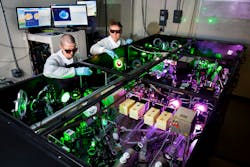University of Michigan to build highest-peak-power laser in the U.S. at 3 PW
The United States is upgrading its laser capabilities with ZEUS, a new three-petawatt (3 PW) system to be built at the University of Michigan (U-M; Ann Arbor, MI). Funded with $16 million from the National Science Foundation (NSF), the facility will enable both basic and applied research. It will test a leading theory on how the universe operates at a subatomic level, and it could lead to advancements in medicine, materials science and national security.
“This laser will have the highest peak power in the United States and will be among the world’s most powerful laser systems for the next decade,” said Karl Krushelnick, director of the Gérard Mourou Center for Ultrafast Optical Science at U-M, where the laser will be built.
The U.S. built the world’s first petawatt laser in 1996, but hasn’t kept pace with more ambitious systems under construction elsewhere in the world. This includes two 10 PW lasers in Europe and a 5.3 PW laser in China, which also has plans to build a 100 PW laser.
Getting back into the game with a 3 PW laser for $16 million is a bargain. The cost savings comes in part from the fact that some high-power laser components are now produced commercially, so they don’t need to be custom built. In addition, ZEUS will be an upgrade of an existing 0.5 PW laser, known for roughly two decades as HERCULES.
ZEUS will be what is known as a “user facility,” providing access to extreme laser intensities to scientists and engineers across the country.
“The NSF-supported ZEUS user facility will reestablish the United States as a world leader in high-intensity laser science, as recently recommended by the National Academies,” said Slava Lukin, who directs the NSF plasma physics program. “More than that, it will help advance our understanding of the cosmos by re-creating some of the universe’s most energetic light and particle acceleration phenomena in a university laboratory setting.”
One of the signature experiments planned will shoot the laser at a high-energy electron beam going the opposite way. This way, researchers will be able to mimic a much more powerful zettawatt laser (that’s 1 quintillion watts, or a 1 followed by 21 zeros). With this capability, the U-M team is most excited about the possibility of probing quantum electrodynamics, the reigning explanation of how the universe operates at the subatomic level.
In addition to trying to answer these very fundamental questions, ZEUS could help develop methods and technologies for use in medicine, defense, materials science and astrophysics, such as making advanced cancer therapies more widely available to patients by shrinking the accelerators needed to generate proton beams and radioactive isotopes, improving detection nuclear weapons materials in shipping containers, exploring how materials change on very fast timescales, and providing new insights into black holes by exploring the high-energy electron-positron jets they are believed to emit.
The funding for ZEUS is part of the NSF’s Mid-Scale Research Infrastructure program.
SOURCE: University of Michigan; https://news.umich.edu/most-powerful-laser-in-the-us-to-be-built-at-u-m/

Gail Overton | Senior Editor (2004-2020)
Gail has more than 30 years of engineering, marketing, product management, and editorial experience in the photonics and optical communications industry. Before joining the staff at Laser Focus World in 2004, she held many product management and product marketing roles in the fiber-optics industry, most notably at Hughes (El Segundo, CA), GTE Labs (Waltham, MA), Corning (Corning, NY), Photon Kinetics (Beaverton, OR), and Newport Corporation (Irvine, CA). During her marketing career, Gail published articles in WDM Solutions and Sensors magazine and traveled internationally to conduct product and sales training. Gail received her BS degree in physics, with an emphasis in optics, from San Diego State University in San Diego, CA in May 1986.
